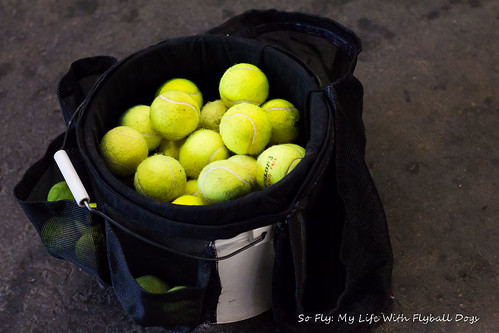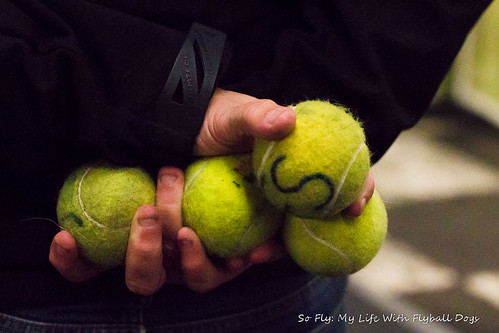For some teams, boxloading is super easy. For others, it can be horribly complicated. I got off pretty easy with three of the six dogs on the team I was loading for all taking a normal size tennis ball and all in the same hole on the box. Most flyball boxes have four holes, two on the right and two on the left, and it is essential to put the ball in the right hole so that the dog can smoothly grab it while doing its trained turn. Also of key importance is getting the right kind of ball into that hole, and doing it in the right order during a lineup of 4 dogs.
For instance, Koira takes a racquetball in the far left hole- which is to the boxloader's right when standing on the box. Pallo's ball goes in that same hole, but is a small size tennis ball. The ball options I know of people using include regular tennis balls, small tennis balls, half bounce tennis balls, racquetballs, squishy balls, small squishy balls, fuzzy chuck-it balls, rubber chuck-it balls, black tennis balls, and foam balls. There is certainly a possibility that other people are using other balls as well! And while some dogs will still run okay if the wrong ball is loaded for them (Pallo will carry a full size tennis ball most of the time just fine), others will completely ignore the ball or spit it out if it is the wrong one (such as the Jack Russel on our team who uses fuzzy chuck-it balls).
 |
| Another method of organizing all of the different types of balls used by a team. You can see this team mostly uses standard tennis balls and small size balls. |
So the boxloader of a team might get off easy (like I did) and just have to chant to themselves: right tennis, right tennis, right tennis, left small squishy. Or, they might get a more complicated line up like: right big hole tennis ball, left small hole small tennis, left big hole rubber chuck-it ball, left big hole racquetball. And, keep in mind, while only four dogs run at once, you are allowed to change the order of those dogs during the race, or switch out any of those four for an alternate dog listed on the team (each team can list up to 6 dogs). So the boxloader has to have really good communication during the race from their team in order to keep up with any changes in the lineup.
 |
| Another sample ball bucket, with tennis balls, small balls, half bounce balls, and small squishy balls |
In addition to loading the box for the team during the race, the boxloader has some other responsibilities. The most important one is to know which side of which ring their team is going to be in for the next race and get the box into the ring and set up, get the ball buckets set behind the barricades where they can be reached to restock balls between heats, and help with the warm ups. Extra people sometimes will help with these tasks as well, especially if the warm ups use a lot of props.
Boxloading can be a lot of fun. You are right in there as part of the action, and you are absolutely essential for the success of your team.



Hi,
ReplyDeleteI'm boxloader for polish team Unleashed Road Runners. I have started to be part of team, when I had no my own dog. So it was funny :)
Our boxes have only two wholes, but we use small and regular tennis balls. You have really hard work! :)
At the beginning it was tricky to have fast reaction, but now I have more calm inside me.
Right now, I have a dog, it's 5 month old, and we are waiting for spring to start a flyable course. Maybe he will be grate flyball dog, if not it will be good too, because I really enjoy be boxloader! Be part of team :)
Best from Poland,
Ania